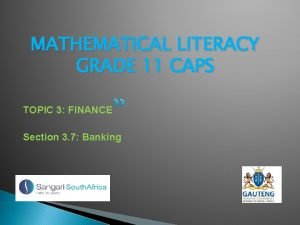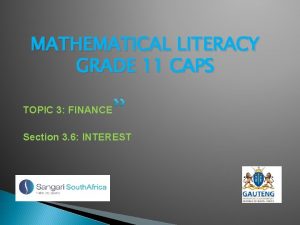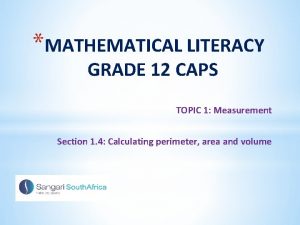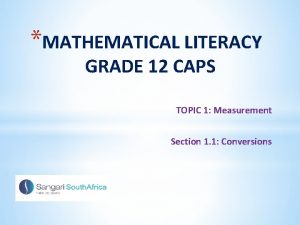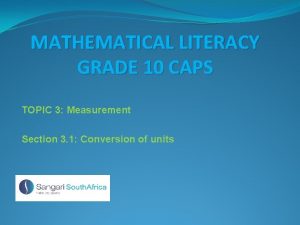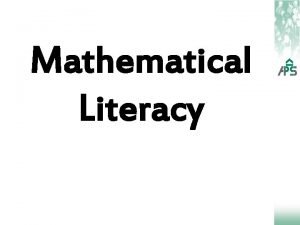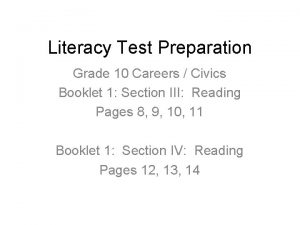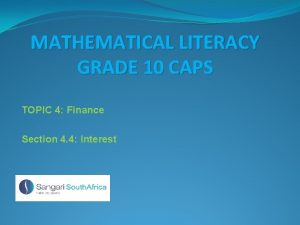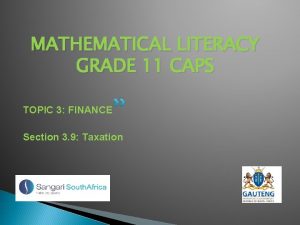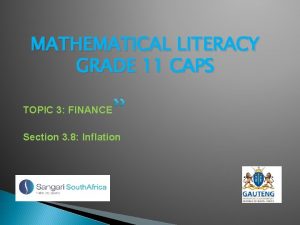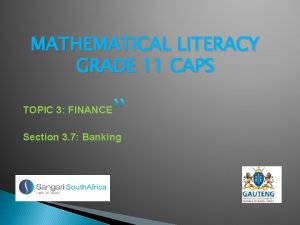MATHEMATICAL LITERACY GRADE 11 CAPS TOPIC 3 FINANCE



























- Slides: 27

MATHEMATICAL LITERACY GRADE 11 CAPS TOPIC 3: FINANCE Section 3. 6: INTEREST

Topic 3: Finance The following sections will be covered: 3. 1. Financial documents 3. 2. Tariff system 3. 3. Income, Expenditure, Profit/ Loss, Income-andexpenditure statements and budgets 3. 4. Cost price and Selling price 3. 5. Break-even-analysis 3. 6. Interest 3. 7. Banking 3. 8. Inflation 3. 9. Taxation (VAT and UIF) 3. 10. Exchange

Topic 3: Interest In section 3. 6 learners will be able to: - Perform calculations involving simple and compound interest through manual calculations and without the use of formulae. - Represent simple interest growth scenarios using linear graphs and compound interest growth scenarios using graphs showing compound change, in order to Investigate the following scenarios - loan agreements between family members where repayments are made only once at the end of the loan - investments in fixed deposit accounts where the money is deposited and withdrawn from the account only once - bank accounts with a changing balance

Finance: Interest

Finance: Interest Simple interest is a percentage of the original amount. This set amount is added each time interest is added. Compound interest is different because the amount added each time depends not only on the original amount but also on the amounts of interest already added.

Example 1 Loan agreement and repayment Cresence is in his first year of university and wants to buy a small second hand car. His sister already has a job agrees to loan him 20 000 which is the cost price of his car. She is able to put up the money immediately but he will have to save a bit every month so that he can afford to pay back the lump sum (with interest) after 2 years. His sister says he must pay 9% p. a. simple interest.

Example 1 cont. (a) What amount will he have to pay at the end of the 2 years? (b) If he wants to save an equal amount of money every month, how much must he save each month in order to pay back the loan including (c) interest after 2 years? How much more will Cresence have to pay his sister if she charges him compound interest over the two years?

Solution: Example 1 �

Solution Example 1 �

Interest on fixed deposit At Bank A, for a special savings account designed for young people, an initial deposit of R 20 is required. Interest is earned at 15% p. a. compounded monthly. Lesego decides to save R 50 per month at Bank A. How much money will Lesego have at the end of 6 months?

Interest on fixed deposit His first payment of R 50 is made at the beginning of month one and he makes payments for 6 months. We can show this on the time line Month 1 R 50 Month 2 R 50 Month 3 R 50 Month 4 Month 5 R 50 Month 6 R 50

Interest on fixed deposit The interest rate is 15% p. a. , compounded monthly. This means that his savings will earn interest at 15% p. a. compounded monthly (which gives him 1, 25% per month). We can draw up a table to show the increasing deposit and interest earned.

Interest on fixed deposit Month Amount at the start Interest earned New deposit amount Total amount at the end of the year 1 R 50, 00 R 0, 63 R 50, 00 R 100, 63 2 R 100, 63 R 1, 26 R 50, 00 R 151, 88 3 R 151, 88 R 1, 90 R 50, 00 R 203, 78 4 R 203, 78 R 2, 55 R 50, 00 R 256, 33 5 R 256, 33 R 3, 20 R 50, 00 R 309, 53 6 R 309, 53 R 3, 87 R 313, 40

Bank account with a changing balance Joe is looking at two investment options and trying to decide which option is best. He wants to invest R 6 000 in a saving account for twenty years. Joe considers the following options: �Option 1: Offers 12% simple interest per year. �Option 2: offers 10% compound interest per year.

Bank account with a changing balance Joe draws up a table to determine how much he will have in his account for each option: (a) (b) Year 0 1 Option 1 6000 6720 Option 2 6000 6600 2 3 4 5 7440 8160 8800 9600 7260 7986 8784, 60 9663, 06 Which option has the highest interest rate per annum? Does the option with the highest interest rate give the highest balance after 20 years? Explain your answer.

Bank account with a changing balance Joe uses the information in the table to draw these graphs (c) 18000 16000 Compound interest 14000 12000 10000 8000 Simple interest 6000 4000 2000 0 0 4 6 8 10 12 14 16 18 20

Bank account with a changing balance (i) Describe the shape of each graph. Relate the shape of each graph to the interest earned over the 20 years. (ii) After how many years does it start becoming more profitable to have the compound interest option?

Bank account with a changing balance (a) Option 1 , the simple interest option (b) No, Even though Joe could earn 12% simple interest per annum and only 10% compound interest per annum, he will still earn more after investing for 20 years with the compound interest option. (c) (i) the shape of the simple interest investment is a straight line. This is because the same amount of interest is being added each year. (ii) After 12 years

Final Assessment Questions 1 -10 Use the information to answer Q 1 - Q 7 Mulalo wants to invest R 5000. He has two options: Denbank offers: Open a SUPER SAVE Den. Bank Open a super save account and earn Account Today! 5% interest per year on the balance in your account MAKGOTLA STOKVEL offers EARN INTEREST ON YOUR INTEREST 6% simple interest per year on your investment

Questions 1, 2 & 3 1. Does the Denbank Super Save account offers simple or compound interest? Explain your answer. 2. If Mulalo decides to invest with Makgotla Stokvel for three years, how much interest will he have earned after three years. Show your calculations. 3. How much will he have in his account in total after three years?

Question 4, 5 & 6 If Mulalo decides to invest with Denbank, show that he will have: 4) R 5 250, 00 in his account after the first year. 5) R 5 512, 50 in his account after the second year. 6) R 5 788, 13 in his account after the third year.

Question 7 Which option is the better investment? Justify your answer. A: Super save account- they offer interest rate. B: Makgotla stokvel- they offer a higher interest rate C: Makgotla stokvel- they offer a lesser interest rate D: none

Question 8 Thembi borrows R 3 000 from her cousin to pay for her daughter’s school fees. Every month she pays her cousin 2% simple interest on the loan amount. Calculate the interest Thembi pays for one month. A: R 57, 50 B: R 55, 50 C: R 60, 00 D: R 74, 50

Information for question 9 &10 Use the table below to answer number 9 and 10. The table shows the number of days it takes painters to paint a house: No. of painters 1 2 3 4 Days to paint a house 24 12 8 6

Question 9 Explain why the amount Thembi pays every month stays the same every month.

Question 10 How much interest would Thembi have paid after 1 year? A: R 360, 00 B: R 100, 00 C: R 540, 00 D: R 720, 00

Solutions Final Assessment Questions �
 Maps plans and other representations of the physical world
Maps plans and other representations of the physical world Credit meaning in maths lit
Credit meaning in maths lit Compound interest maths literacy
Compound interest maths literacy Mathematical literacy grade 11 assignment topic measurement
Mathematical literacy grade 11 assignment topic measurement Grade 10 maths literacy finance
Grade 10 maths literacy finance Mathematical literacy grade 12 finance and measurement
Mathematical literacy grade 12 finance and measurement Till slip maths lit
Till slip maths lit Types of maps in maths lit grade 12
Types of maps in maths lit grade 12 Mathematical literacy grade 10 measurements
Mathematical literacy grade 10 measurements Conversions maths literacy grade 12
Conversions maths literacy grade 12 Packaging in maths lit
Packaging in maths lit Mathematical literacy grade 12 exchange rate
Mathematical literacy grade 12 exchange rate Mathematical literacy grade 10 measurements
Mathematical literacy grade 10 measurements Measurement grade 10
Measurement grade 10 Elevation map maths lit
Elevation map maths lit Caps topic
Caps topic Non mathematical economics
Non mathematical economics Types of data in maths lit
Types of data in maths lit Difference between mathematics and mathematical literacy
Difference between mathematics and mathematical literacy Media literacy vs information literacy comparison
Media literacy vs information literacy comparison Venn diagram about media and information literacy
Venn diagram about media and information literacy People media value
People media value Cyber literacy for the digital age
Cyber literacy for the digital age Examples of clinchers
Examples of clinchers /topic/ down
/topic/ down Literacy by design grade 2
Literacy by design grade 2 Pfl math
Pfl math Grade 10 literacy test
Grade 10 literacy test

